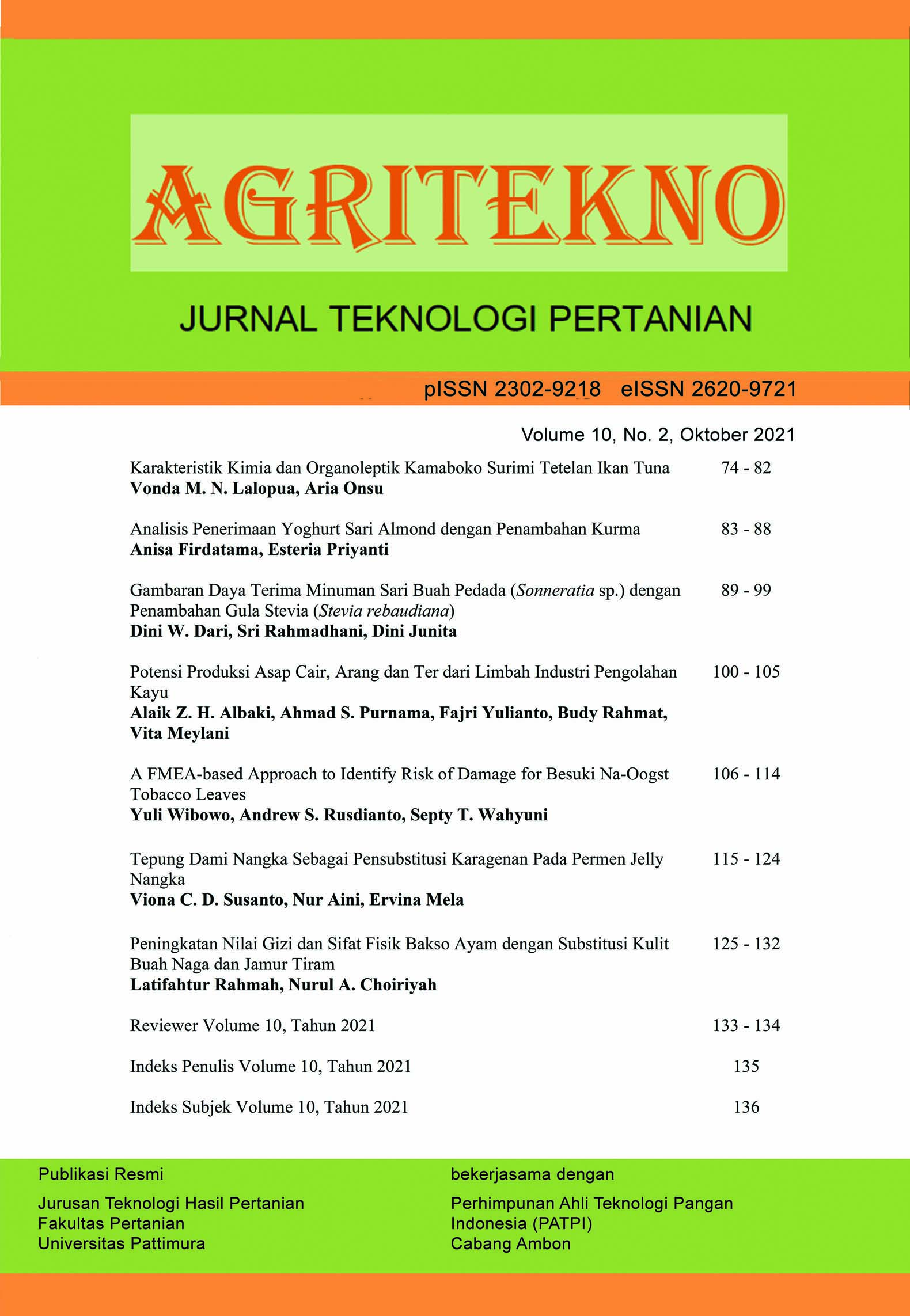Potensi Produksi Asap Cair, Arang dan Tar dari Limbah Industri Pengolahan Kayu
Abstract
The practice of burning and stockpiling to reduce wood waste from the wood processing industry is not in line with the demands of clean production, environmentally friendly and sustainable industries. Pyrolysis technology can be used to produce bioenergy from wood waste. The temperature and the time of the pyrolysis process, the water content of materials, and the content of different yields between types of wood waste affect the bioenergy products produced. This study was aimed at determining the effect of wood waste form and condition on the quality and quantity of liquid smoke, tar, and charcoal. A Completely Randomized Design with two factors of treatments, i.e., waste forms and the drying process, was applied in this research. The results showed that the condition and shape of the material affect the volume of liquid smoke and the weight of the charcoal produced. The condition of the material without drying with high water content and the shape of the chunks produce more liquid smoke with an average yield of 191.14 mL and 186.37 mL, while the charcoal produced is higher in the condition of the material with drying and shaved form at 125.83 g and 115.62 g. The results of the test characteristics of grade 1 and 2 distillation liquid smoke meet the Japanese liquid smoke quality standards with phenol levels in the range of 26.66-35.94 mg GAE/mL sample and acidity levels of 16.91-58.9%.
Keywords: Char; liquid smoke; pyrolysis; tar; wood waste.
ABSTRAK
Praktik pembakaran dan penimbunan untuk mereduksi limbah kayu dari industri pengolahan kayu tidak selaras dengan tuntutan produksi bersih, ramah lingkungan dan industri berkelanjutan. Teknologi pirolisis dapat digunakan untuk memproduksi bioenergi dari limbah kayu dengan suhu dan waktu proses pirolisis, kadar air bahan serta kandungan rendemen yang berbeda antar jenis limbah kayu mempengaruhi produk bioenergi yang dihasilkan. Penelitian ini bertujuan untuk mengetahui pengaruh bentuk dan kondisi limbah kayu terhadap kualitas dan kuantitas asap cair, ter dan arang. Metode penelitian yang dilakukan adalah Rancangan Acak Lengkap yang disusun secara faktorial dengan perlakuan bentuk limbah dan proses pengeringan. Hasil penelitian menunjukan bahwa kondisi dan bentuk bahan mempengaruhi volume asap cair dan bobot arang yang dihasilkan. Kondisi bahan tanpa pengeringan dengan kadar air tinggi dan bentuk bongkah menghasilkan asap cair lebih banyak dengan hasil rata-rata 191,14 mL dan 186,37 mL, sedangkan arang yang dihasilkan lebih tinggi pada kondisi bahan dengan pengeringan dan bentuk serut yaitu 125,83 g dan 115,62 g. Hasil uji karakteristik asap cair distilasi grade 1 dan 2 memenuhi standar mutu asap cair Jepang dengan kadar fenol berada pada kisaran 26,66-35,94 mg GAE/mL sampel dan kadar keasaman 16,91-58,9 %.
Kata kunci: Arang; asap cair; limbah kayu; pirolisis; ter.
Downloads
References
Alpian, T.A. Prayitno, J.P.G. Sutapa, dan Budiadi. 2014. Kualitas asap cair batang gelam (Melaleuca sp.). Jurnal Penelitian Hasil Hutan 32: 83–92. DOI: 10.20886/jphh.2014.32.2.83-92.
Chan, K.Y. and Z. Xu. 2009. Biochar: Nutrient Properties and Their Enhancement. Lehman, J. and S. Joseph (Eds.) Biochar for Environmental Management: Science and Technology. UK: Earthscan p. 67-84.
Hartati, S., R. Meliansyah, dan L.T. Puspasari. 2013. Potensi cuka kayu pinus dalam pengendalian penyakit antraknosa pada cabai merah. Jurnal Fitopatologi Indonesia 9: 173-178. DOI: 10.14692/jfi.9.6.173.
Noor, E., C. Luditama, dan G. Pari. 2014. Isolasi dan pemurnian asap cair berbahan dasar tempurung dan sabut kelapa secara pirolisis dan distilasi. In: Prosiding Konferensi Nasional Kelapa VIII, hal. 93-102.
Nurhayati, T., R.A. Pasaribu, dan D. Mulyadi. 2006. Produksi dan pemanfaatan arang dan cuka kayu dari serbuk gergaji kayu campuran. Jurnal Penelitian Hasil Hutan 24: 395–411. DOI: 10.20886/jphh.2006.24.5.395-411.
Purwanto, D. 2011. Pembuatan balok dan papan dari limbah industri kayu. Jurnal Riset Industri 5: 13-20.
Rahmat, B., D. Pangesti, D. Natawijaya, and D. Sufyadi. 2014. Generation of wood-waste vinegar and its effectiveness as a plant growth regulator and pest insect repellent. BioResources 9: 6350-6360.
Setiawan, W. 2015. Pengaruh Asap Cair Tempurung Kelapa Terhadap Patogen Busuk Lunak (Rhizopus stolonifer) Pada Buah Stroberi (Fragaria × ananassa). Skripsi. Fakultas Pertanian. Universitas Siliwangi.
Tahir, M., A. Muflihunna, dan Syafrianti. 2017. Penentuan kadar fenolik total ekstrak etanol daun Nilam (Pogostemon cablin Benth.) dengan metode spektrofotometri UV-Vis. Jurnal Fitofarmaka Indonesia 4: 215-218. DOI: 10.33096/jffi.v4i1.231.
Tiilikkala, K., L. Fagernäs, and J. Tiilikkala. 2010. History and use of wood pyrolysis liquids as biocide and plant protection product. The Open Agriculture Journal 4: 111-118. DOI: 10.2174/1874331501004010111.
Wibowo, S. 2012. Karakteristik asap cair tempurung nyamplung. Jurnal Penelitian Hasil Hutan 30: 217–226. DOI: 10.20886/jphh.2012.30.3.218-227
Wilson, Supriadi, dan H. Guchi. 2015. Evaluasi sifat kimia tanah pada lahan kopi di Kabupaten Mandailing Natal. Jurnal Online Agroekoteknologi 3: 642-648.
Yokoyama, S. and Y. Matsumura. 2008. The Asian Biomass Handbook: A Guide for Biomass Production and Utilization Support. 1 ed. Tokyo: Ministry of Agriculture, Forestry and Fisheries.
Copyright (c) 2021 The Authors

This work is licensed under a Creative Commons Attribution-ShareAlike 4.0 International License.
Authors who publish with this journal agree to the following terms:
- Authors retain copyright and grant the journal the right of first publication with the work simultaneously licensed under a Creative Commons Attribution License that allows others to share the work with an acknowledgement of the work's authorship and initial publication in this journal.
- Authors are able to enter into separate, additional contractual arrangements for the non-exclusive distribution of the journal's published version of the work (e.g., post it to an institutional repository or publish it in a book), with an acknowledgement of its initial publication in this journal.
- Authors are permitted and encouraged to post their work online (e.g., in institutional repositories or on their website) prior to and during the submission process, as it can lead to productive exchanges, as well as earlier and greater citation of published work (See The Effect of Open Access).









